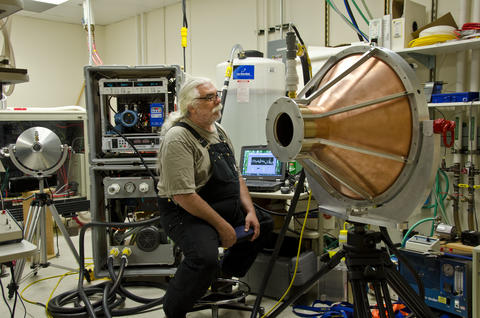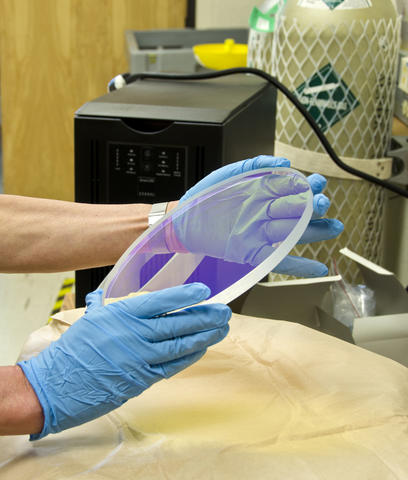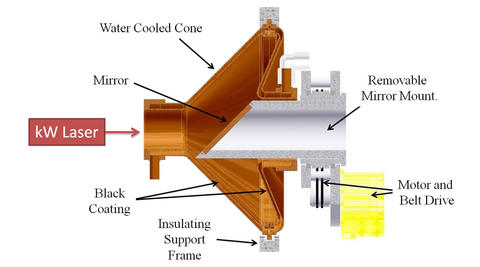
Chris Cromer examines one of PML’s next-generation power meters, built for the Air Force, that is capable of handling inputs as high as 100 kW. In the center of the frame are the stacked, shippable plastic crates containing the analytics (top) and flow control (bottom). Behind Cromer is the 100-gallon water tank. At far left is the smaller 10kW power meter.
"If you made a long distance phone call or sent an email today, or if you're wearing clothes, then you are benefiting directly from our laser services," says Marla Dowell, leader of PML's Sources and Detectors Group, the nation's keeper of a family of standards that now permit laser calibrations at power levels from nanowatts to hundreds of kilowatts and energy levels from femtojoules to megajoules.
Accurate measurements at the high end of that scale, 10 kW and above, were virtually impossible until recently, when NIST researchers devised a novel power meter for lasers in that range. And now the team has scaled up the device to handle beams 10 times stronger.
Such measurements are of urgent interest to the global laser industry – and in particular to the world-leading U.S. laser industry – because lasers are used for cutting and welding a wide variety of materials from steel and aluminum for automobiles and airplanes to fabrics and plastics, and for drilling tiny holes in devices such as iPhones. Such applications, and numerous military uses such as defusing unexploded land mines, require exact knowledge of the laser output.
In addition, there are financial considerations. "Industrial laser manufacturers typically price their products by power," Dowell says, "and the cost averages around $50,000 per kilowatt. So there's a big difference between 10 kW and 9 kW. Buyers want to know the power output to within a percent.
"But there's a major problem: A laser powerful enough to cut stuff will damage conventional measurement equipment." So Dowell's group in PML's Quantum Electronics and Photonics Division has long been at work on a next-generation device that would do the job. The result, thanks to veteran researchers Chris Cromer, Xiaoyu Li, and John Lehman, is a high-tech, flowing-water optical power meter to measure outputs at familiar industrial power levels – and now to the stupendous intensities required for military use.
"Right now," Cromer says, "among the power meters we're building for the Air Force is one for very high-power lasers up to 100 kW." By comparison, an industrial laser of one-tenth that power will slice through carbon steel. So a high damage threshold, around 10 kW/cm2, was an absolutely essential design goal.

The cavity is surrounded by a hollow-walled copper enclosure through which water from a 100-gallon tank flows at a carefully controlled rate – 10 liters per minute on the 10 kW units, 80 liters per minute on 100 kW model. Cromer and colleagues measure the temperature difference between the incoming and outgoing water. That number, factored together with the flow rate and heat capacity of the water, is a sensitive measure of power. (By increasing the flow rate, the researchers expect to be able to make future measurements potentially up to the gigawatt power level.)
Finding a suitable material to coat the inside of the cavity entailed a long and complex research process, headed by Lehman. The team wanted to take advantage of the profound blackness and damage-resistance of carbon nanotubes as well as the heat tolerance of ceramics. But a composite nanotube-ceramic coating will not stick to copper. Lehman's eventual solution was to grind the nanotube-ceramic material into a powder and mix it with a potassium silicate ("water glass") binder that did not affect the high damage threshold. The spray-on coating, which holds the world record for damage threshold in these sorts of applications, is easy to apply and highly robust.
Of course, the old NIST power meter was also based on beam absorption and water calorimetry. But there the similarities end. The old unit weighs about 600 pounds and is 1.5 meters long. The new 10 kW version is about the size of a beach ball and twice as accurate. Even the 100 kW unit is smaller than a dishwasher. Moreover, Dowell says, "We can do measurements in real time, whereas in the previous system you can only do a measurement about every 20 minutes or so."
Another advantage is that the new system is completely portable in a couple of high-tech crates the size of a doghouse: one for the pump and flow-metering apparatus, and one for the sensor inputs and data analysis. One person can easily move them around.
"The old system was built about 35 years ago. It had to be carted around in its own custom truck and took most of a day to set up," Cromer says. "But the new model is easily shippable and can be up and running in an hour." The system does not require specially purified water. "We found that ordinary drinking water is plenty good enough to the 0.1% level, which is the absolute precision of this instrument," Cromer says, "although the overall accuracy is around 1%."

Although the new power meter is a major advance, power measurement is only one of several problems of concern to the laser industry, Dowell says. "There is also the issue of brightness. A bright laser is like a sharp cutting tool. But at present, NIST does not have the ability to measure brightness or beam profile at high power and energy. For many lasers, accurate knowledge of brightness makes all the difference in laser-safety classification."
In addition, she says, "the shape and duration of a laser pulse is the difference between a cut and a weld. High-power, diode-pumped fiber lasers are changing the role of lasers in manufacturing. At present, however, NIST lacks the infrastructure to characterize high-power pulse parameters." (Existing power meters are limited to about 4 kW or less.)The power-meter team has been working closely with John Brady and Richard Bowling from the Air Force Metrology and Calibration Program on the military order. When that job is complete, Dowell says, "we want to make units for NIST so that we can establish our own in-house standards."

